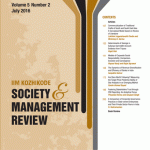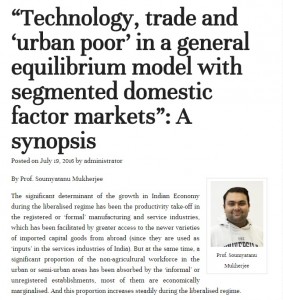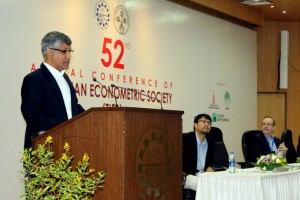E-COMMERCE & CUSTOMER LOYALTY IN INDIA
By:




Jeenam Jindal Hrishikesh Deshmukh Esha Puri Dibyendu Das
According to Ecommerce Europe, Asia Pacific with sales of about 567.3 billion USD is the largest business-to-consumer (B2C) ecommerce market followed by Europe (482.3 billion USD) and North America (452.4 billion USD). Ifwe see country wise statistics then the US, UK and China account for almost 60% of world’s total B2C ecommerce sales with China leading the pack (328.4 billion USD). On the other hand India has sales of around 11 billion USD, less than 5% of that in China.
India’s low internet penetration is touted to be the main reason for the poor sales. According Forester Research, only about 16% of India’s total population are internet users and only 14% of that number (about 28 million) use ecommerce for their shopping needs. India, therefore is in the nascent stage of online retail evolution whereas China (50%) in ascending stage and Japan (69%), Australia (57%) and South Korea (70%) are in mature stage.
This presents a great opportunity for India to be the next big market in this booming space. India’s ecommerce industry is fast rising with CAGR in high 30s since 2009 and is set to touch 22 billion USD in 2015. While, eTravel consists of almost 70% of eCommerce in India, the most happening and promising space to keep a watch on, iseTail.
India’s e Commerce and e Tail growth
eTail includes online retail and market places, with CAGR of almost 56% since 2009 it is all set to touch sales of 6 billion USD in 2015. Primarily a product distribution business, books, apparels, electronics and accessories are largest selling products through eTail. The ever increasing use of smartphones, tablets and availability of internet is shaping this segment further growth. On the other hand India’s demographic dividend makes this segment all the more promising.
Access to technology coupled with large number of homegrowneTail companies with their innovative business models has created a robust eTail market in India. The change in government has turned around the investor sentiment and ecommerce space looks all set to be the next big thing.
While the growth of the sectors excites entrepreneurs and investors alike, there are many challenges waiting to be addressed before we realise the true potential of eTail segment. Players in this space need to strike down several issues but none so importantly as that of customer loyalty.
Over the years, similar operational and functional practices across the eCommerce industry have made it a group of four to five very similar companies. There is hardly any difference in the product offerings, discounts or delivery services (broadly speaking). In the wake of such a scenario, we decided to analyse the factors which drive consumer loyalty in this segment. The research was carried out under the guidance of Prof. Naveen Amblee.
We decided to use a model suggested in a research by Srinavasan, Anderson and Ponnavolu, 2002. According to this model there are eight antecedents to customer loyalty (8Cs)- customization, contact interactivity, cultivation, care, community, choice, convenience and character. Customization is the ability to customize or tailor-make the products for the consumers, customer engagements and developing them into strong associations/ bonds are covered under factors contact interactivity and cultivation respectively. Online community of potential and existing customers and its impact is recorded under variable community. Care signifies the pre and post purchase services while choice refers to the availability of brands and variety of products. The variable convenience is self-explanatory and variablecharacter covers the personal liking towards the eCommerce player due to creative, enjoyable web interface.
Research Model
We conducted a survey to test the impact of these factors on eLoyalty of Indian customers. Data from this survey which revealed very interesting insights, was analysed using SPSS for factor and Regression Analysis. While all these eight factors (8Cs) affected customer loyalty in the US only two of them showed any effect on Indian customers. The two factors were Choice and Character. And between the two, Character was a more predominant in affecting eLoyalty.
The interpretation of this result can prove very fruitful for eCommerce players in India. It clearly points towards the undifferentiated product and services offered by the group of Indian eCommerce players.
Based on our research, we think that following things are in order for eCommerce players in India.
- Experiential commerce: We see that the customers value the experience of shopping, yes even on the internet. It is this experience which seems to bring back customers for repeat purchases. Creative interface yet simple in design can be a good starting point in this regard.
- One-Stop-Shop: Customers today want everything at one web-address. The more the availability of products, brands and categories, the more are the chances of getting your customers back. Here we already see a trend of private labels and exclusive product associations. But a lot still remains to be done.
- While eCommerce in India is set to be humongous business opportunity, it is essential for eCommerce companies to keep moving in the right direction because it’s only then they will reap benefits out of it.
The authors are PGP students at IIM Kozhikode. The work was done under the supervision of Prof. Naveen Amblee, Assistant Professor of Marketing at IIM Kozhikode. Views expressed here are their personal views.

















 Users Today : 244
Users Today : 244 Users Yesterday : 367
Users Yesterday : 367 This Month : 7098
This Month : 7098 This Year : 112226
This Year : 112226 Total Users : 536214
Total Users : 536214 Who's Online : 2
Who's Online : 2